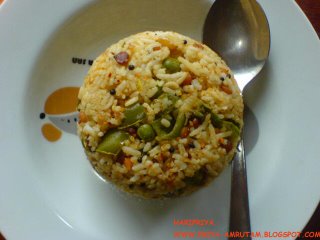

Ingredients
Rice 1 cup
Capsicum 3 nos (large) chopped
Onion 1 chopped
Chana dal 1/4 cup
Urad dal 1/4 cup
Coriander seeds 3 tbsp
Whole Red Chillies 10-14
Cinnamon 1 stick
Cloves 5-6
Green chillies 2 chopped
Cumin seeds 1 tsp
Mustard seeds 1 tsp
Curry leaves few
Coriander leaves few chopped
Lemon Juice 2 tsp
Salt to Taste
Grated coconut 3 tbsp
Method:
Cook the Rice & keep it aside.
Fry Chanadal, Urad dal, coriander seeds, Red Chillies, Cinnamon, Cloves seperately until they become light brown. Then make a smooth powder of all these.
Heat oil in kadai. Then add Mustard seeds, Cumin seeds & saute for a minute. Then add Onions & saute well. Then add Capsicum & fry until they are soft.
After that add the Rice & mix all together very well. Then add the Powder. Add it accordingly the way one likes spice. Mostly add 3 tbsp of the powder & mix it well, sprinkle salt & Lemon Juice & mix it well.
Then add curry leaves & chopped Coriander leaves along with grated coconut. Sprinkle a little more of the powder on top.
Serve Hot.


